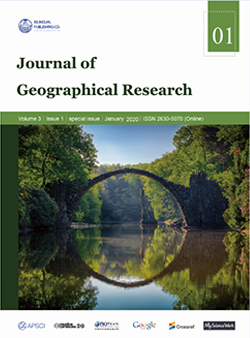-
1378
-
355
-
319
-
225
-
197
Empirical Studies in Alluvial Streams
DOI:
https://doi.org/10.30564/jgr.v3i1.1668Abstract
Meander flow takes place in one single channel which oscillates more or less regularly with amplitudes that tend to increase with time. Meanders are found in beds of fine sediments with gentle slopes. In this study, effort will be made to investigate meanders’ turbulent boundary layer and to improve the present knowledge about the river meandering phenomena. It is assumed that the development of the perturbations which develop into meanders or braids, is longer than the width of the channel. Interaction be tween the flow and mobile boundaries produces channel patterns which are classified as meandering or braided. It is therefore long compared with the ripples or dunes which cover the bed of such a channel and whose wave length is shorter than the width of the channel. The variation of resistance to flow and rate of transport of bed material with velocity are discussed briefly and taken into account. Meander flow and meander shear stress distribu tion of the channel are described. The basis is a steady, two-dimensional model of flow in an alluvial channel with variable curvature. The meander development is described by forcing a travelling, small-amplitude channel alignment wave on the system, and determining the growth characteristics of the wave. Laboratory data are used to verify the formulas.Keywords:
Meander; Sediment transport; Verify data; OscillationReferences
[1] Yilmaz, L.. Meanderbildung, Beitrag in türkisches Wissenschafts-Technologiezentrum e.V.Berlin[IWAWI]. Technische Universitaet Berlin, 1989.
[2] Holtorff, G.. The formation of Bed Waves in Alluvial Channels, Proc. III International Symposium on river sedimentation, Jackson, Miss., USA, 1986.
[3] Vollmers, Pernecker. Beginn des Feststoff-Transportes für feinkörnige Materialien in einer richtunskonstanten Strömung. Wasserwirtschaft, Heft.1967, 6: 236-241.
[4] Eckelmann, H.. The structure of the viscous sublayer and the adjacent wall region in a turbulent channel flow. J. Fluid Mech., 1974: 439-459.
[5] Hanratty, T.J., J. A. Campbell. Measurement of wall shear stress, in fluid mechanics measurements.Edited by R.J. Goldstein, Hemisphere, Washington, D.C.1983: 559-615.
[6] Odgaard, A.J.. River Meander Model. I. Development. J. of Hydraulic Engineering, 1989, 115(11):1433-1451.
[7] Odgaard, A.J.. River Meander Model. II. Applications. J. of Hydraulic Engineering, 1989, 115(11):1451-1465.
[8] Miller, S., Chaudhry, M. H., Dam. Break Flows in Curved Channel. J. of Hydraulic Engineering, 1989,115(11): 1465-1479.
[9] Dammuller, D. C., Bhallamudi, S. M., Chaudhry, M.H.. Modeling of Unsteady Flow in Curved Channel. J.of Hydraulic Engineering, 1989, 115(11): 1479-1496.
[10] Rahuel, J.L., Holly, F.M., Chollet, J.P., Belleudy, P.J.,G. Yang. Modeling of Riverbed Evolution for Bedload Sediment Mixtures. J. of Hydraulic Engineering,1989, 115(11): 1521-1543.
[11] Zimmermann, C., Kennedy, J. F.. Transverse bed slopes in curved alluvial streams. J. of Hydraulic Engineering, 1978, 104(1): 33-48.
[12] Yilmaz, L.. Laboratory Channel Meander, (unpublished material) Nisantasi University,Engineering Faculty, Hydraulic Division, 2020.
Downloads
How to Cite
Issue
Article Type
License
Copyright © 2020 Levent YILMAZ

This is an open access article under the Creative Commons Attribution-NonCommercial 4.0 International (CC BY-NC 4.0) License.




 Levent Yilmaz
Levent Yilmaz





